Inspired by my post for the JEPS Bulletin (Python programming in Psychology), where I try to show how Python can be used from collecting to analyzing and visualizing data, I have started to learn more data exploring techniques for Psychology experiments (e.g., response time and accuracy). Here are some methods, using Python, for visualization of distributed data that I have learned; kernel density estimation, cumulative distribution functions, delta plots, and conditional accuracy functions. These graphing methods let you explore your data in a way just looking at averages will not (e.g., Balota & Yap, 2011).

Table of Contents
- Required Python packages
- Kernel Density Estimation in Python
- Cumulative Distribution Functions in Python
- Delta Plots in Python
- Conditional Accuracy Functions in Python
Required Python packages
I used the following Python packages; Pandas for data storing/manipulation, NumPy for some calculations, Seaborn for most of the plotting, and Matplotlib for some tweaking of the plots. Any script using these functions should import them:
from __future__ import division
import pandas as pd
import numpy as np
import matplotlib.pyplot as plt
import seaborn as snsCode language: Python (python)Learn more about how to install Python packages using pip or conda. Now, sometimes when installing Python packages with pip you get a message that there is a new version of pip. In a more recent post, you’ll learn how to upgrade pip using pip, conda, and Anaconda navigator.
Kernel Density Estimation in Python
The first plot is the easiest to create using Python; visualizing the kernel density estimation. How do you visualize the kernel density estimation? It can be done using the Seaborn package only. kde_plot takes the arguments df Note, in the beginning of the function I set the style to white and to ticks. I do this because I want a white background and ticks on the axes.
def kde_plot(df, conditions, dv, col_name, save_file=False):
sns.set_style('white')
sns.set_style('ticks')
fig, ax = plt.subplots()
for condition in conditions:
condition_data = df[(df[col_name] == condition)][dv]
sns.kdeplot(condition_data, shade=True, label=condition)
sns.despine()
if save_file:
plt.savefig("kernel_density_estimate_seaborn_python_response"
"-time.png")
plt.show()Code language: Python (python)Using the function above you can basically plot as many conditions as you like (however, but with to many conditions, the plot will probably be cluttered). Here I use some response time data from a Flanker task to create a kde plot with Python using Seaborn:
# Load the data
frame = pd.read_csv('flanks.csv', sep=',')
# Plot the response time distributions by condition/groups:
kde_plot(frame, ['incongruent', 'congruent'], 'RT', 'TrialType',
save_file=False)Code language: Python (python)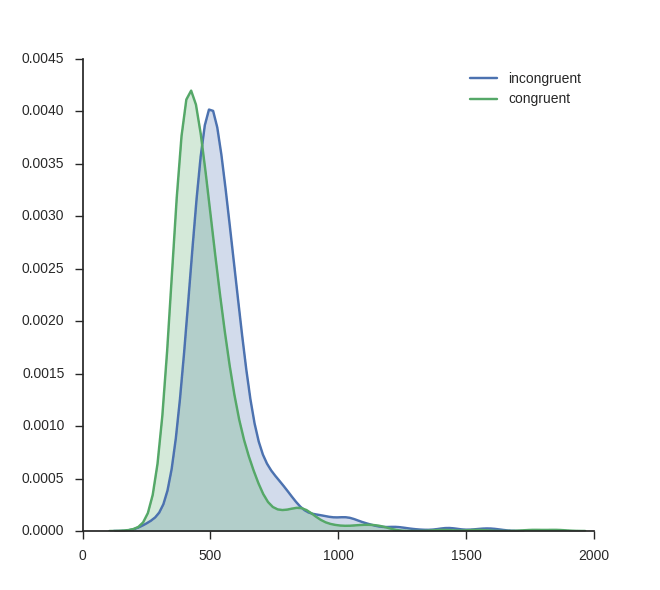
Note, you can easily create your own Flanker Task. For example, see my OpenSesame tutorial to learn how to create a flanker task.
Cumulative Distribution Functions in Python
Next out is to plot the cumulative distribution functions (CDF). In the first function CDFs for each condition will be calculated. It takes the arguments df (a Pandas dataframe), a list of the conditions (i.e., conditions).
# Calculating the Cumulative distribution function:
def cdf(df, conditions=['congruent', 'incongruent']):
data = {i: df[(df.TrialType == conditions[i])] for i in range(len(
conditions))}
plot_data = []
for i, condition in enumerate(conditions):
rt = data[i].RT.sort_values()
yvals = np.arange(len(rt)) / float(len(rt))
# Append it to the data
cond = [condition]*len(yvals)
df = pd.DataFrame(dict(dens=yvals, dv=rt, condition=cond))
plot_data.append(df)
plot_data = pd.concat(plot_data, axis=0)
return plot_dataCode language: Python (python)Python CDF Plot with Seaborn
Next is the plot function (cdf_plot). The function takes a Pandas a dataframe (created with the function above) as parameter as well as save_file and legend.
def cdf_plot(cdf_data, save_file=False, legend=True):
sns.set_style('white')
sns.set_style('ticks')
g = sns.FacetGrid(cdf_data, hue="condition", size=8)
g.map(plt.plot, "dv", "dens", alpha=.7, linewidth=1)
if legend:
g.add_legend(title="Congruency")
g.set_axis_labels("Response Time (ms.)", "Probability")
g.fig.suptitle('Cumulative density functions')
if save_file:
g.savefig("cumulative_density_functions_seaborn_python_response"
"-time.png")
plt.show()Code language: Python (python)Here is how to create the plot on the same Flanker task data as above:
cdf_dat = cdf(frame, conditions=['incongruent', 'congruent'])
cdf_plot(cdf_dat, legend=True, save_file=False)Code language: Python (python)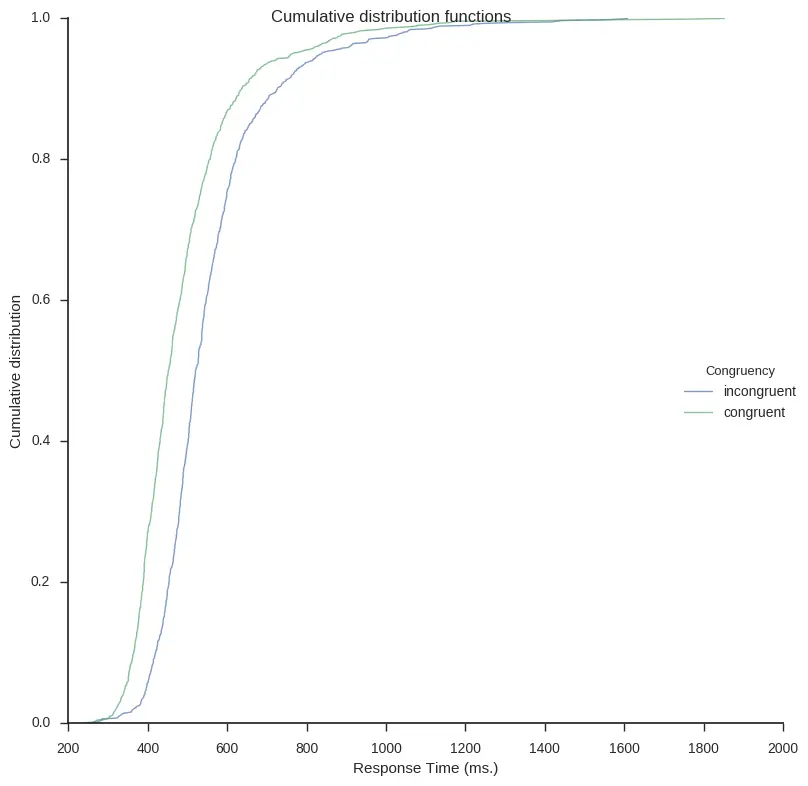
Delta Plots in Python
In Psychological research, delta plots (DPs) can be used to visualize and compare response time (RT) quantiles obtained under two experimental conditions. DPs enable examination whether the experimental manipulation has a larger effect on the relatively fast responses or on the relatively slow ones (e.g., Speckman, Rouder, Morey, & Pratte, 2008).
In the following script I have created two functions; calc_delta_data and delta_plot. calc_delta_data takes a Pandas dataframe (df). Rest of the arguments you need to fill in the column names for the subject id, the dependent variable (e.g., RT), and the conditions column name. All in the string data type. The last argument should contain a list of strings of the factors in your condition.
def calc_delta_data(df, subid, dv, condition, conditions=['incongruent',
'congruent']):
subjects = pd.Series(df[subid].values.ravel()).unique().tolist()
subjects.sort()
deciles = np.arange(0.1, 1., 0.1)
cond_one = conditions[0]
cond_two = conditions[1]
# Frame to store the data (per subject)
arrays = [np.array([cond_one, cond_two]).repeat(len(deciles)),
np.array(deciles).tolist() * 2]
data_delta = pd.DataFrame(columns=subjects, index=arrays)
for subject in subjects:
sub_data_inc = df.loc[(df[subid] == subject) & (df[condition] ==
cond_one)]
sub_data_con = df.loc[(df[subid] == subject) & (df[condition] ==
cond_two)]
inc_q = sub_data_inc[dv].quantile(q=deciles).values
con_q = sub_data_con[dv].quantile(q=deciles).values
for i, dec in enumerate(deciles):
data_delta.loc[(cond_one, dec)][subject] = inc_q[i]
data_delta.loc[(cond_two, dec)][subject] = con_q[i]
# Aggregate deciles
data_delta = data_delta.mean(axis=1).unstack(level=0)
# Calculate difference
data_delta['Diff'] = data_delta[cond_one] - data_delta[cond_two]
# Calculate average
data_delta['Average'] = (data_delta[cond_one] + data_delta[cond_two]) / 2
return data_deltaCode language: Python (python)Next function, delta_plot, takes the data returned from the calc_delta_data function to create a line graph.
def delta_plot(delta_data, save_file=False):
ymax = delta_data['Diff'].max() + 10
ymin = -10
xmin = delta_data['Average'].min() - 20
xmax = delta_data['Average'].max() + 20
sns.set_style('white')
g = sns.FacetGrid(delta_data, ylim=(ymin, ymax), xlim=(xmin, xmax), size=8)
g.map(plt.scatter, "Average", "Diff", s=50, alpha=.7, linewidth=1,
edgecolor="white")
g.map(plt.plot, "Average", "Diff", alpha=.7, linewidth=1)
g.set_axis_labels("Avarage RTs (ms.)", "Effect (ms.)")
g.fig.suptitle('Delta Plot')
if save_file:
g.savefig("delta_plot_seaborn_python_response-time.png")
plt.show()
sns.plt.show()Code language: Python (python)Here’s how to use the two above functions. First, we read the Flanker Task data using Pandas read_csv(). Second, we calculate the data needed to create a delta plot. Finally, we use the function to create a delta plot:
# Load the data
frame = pd.read_csv('flanks.csv', sep=',')
# Calculate delta plot data and plot it
d_data = calc_delta_data(frame, "SubID", "RT", "TrialType", ['incongruent',
'congruent'])
delta_plot(d_data)Code language: Python (python)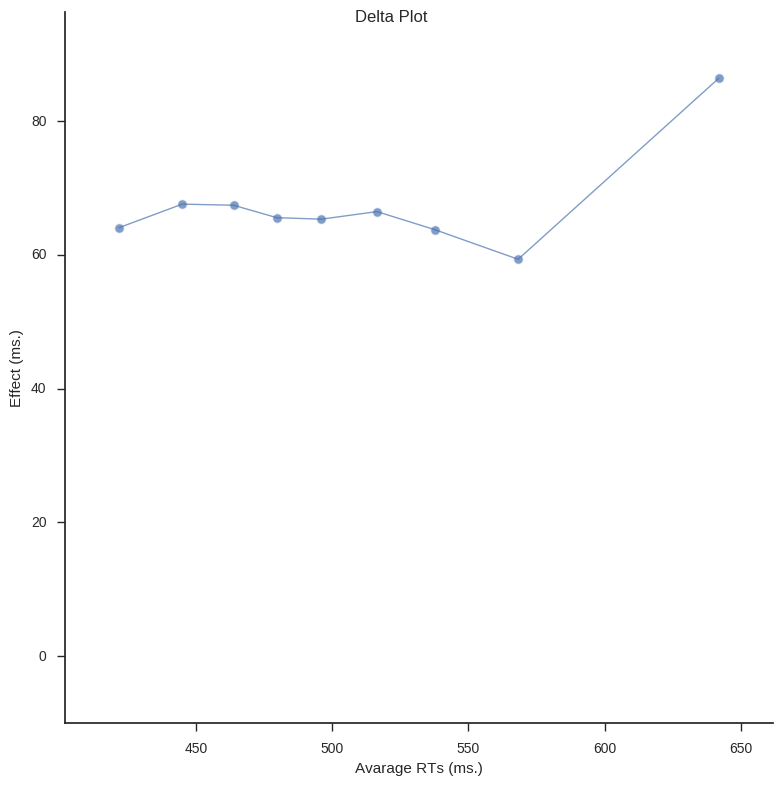
Conditional Accuracy Functions in Python
Conditional accuracy functions (CAF) is a technique that also incorporates the accuracy in the task. Creating CAFs involves binning your data (e.g., the response time and accuracy) and creating a line graph with Seaborn. Briefly, CAFs can capture patterns related to speed/accuracy trade-offs (see Richard, 2014). First function:
def calc_caf(df, subid, rt, acc, trialtype, quantiles=[0.25, 0.50, 0.75, 1]):
# Subjects
subjects = pd.Series(df[subid].values.ravel()).unique().tolist()
subjects.sort()
# Multi-index frame for data:
arrays = [np.array(['rt'] * len(quantiles) + ['acc'] * len(quantiles)),
np.array(quantiles * 2)]
data_caf = pd.DataFrame(columns=subjects, index=arrays)
# Calculate CAF for each subject
for subject in subjects:
sub_data = df.loc[(df[subid] == subject)]
subject_cdf = sub_data[rt].quantile(q=quantiles).values
# calculate mean response time and proportion of error for each bin
for i, q in enumerate(subject_cdf):
quantile = quantiles[i]
# First
if i < 1:
# Subset
temp_df = sub_data[(sub_data[rt] < subject_cdf[i])]
# RT
data_caf.loc[('rt', quantile)][subject] = temp_df[rt].mean()
# Accuracy
data_caf.loc[('acc', quantile)][subject] = temp_df[acc].mean()
# Second & third (if using 4)
elif i == 1 or i < len(quantiles):
# Subset
temp_df = sub_data[(sub_data[rt] > subject_cdf[i - 1]) & (
sub_data[rt] < q)]
# RT
data_caf.loc[('rt', quantile)][subject] = temp_df[rt].mean()
# Accuracy
data_caf.loc[('acc', quantile)][subject] = temp_df[acc].mean()
# Last
elif i == len(quantiles):
# Subset
temp_df = sub_data[(sub_data[rt] > subject_cdf[i])]
# RT
data_caf.loc[('rt', quantile)][subject] = temp_df[rt].mean()
# Accuracy
data_caf.loc[('acc', quantile)][subject] = temp_df[acc].mean()
# Aggregate subjects CAFs
data_caf = data_caf.mean(axis=1).unstack(level=0)
# Add trialtype
data_caf['trialtype'] = [condition for _ in range(len(quantiles))]
return data_cafCode language: Python (python)Right now, the function for calculation the Conditional Accuracy Functions can only do one condition at the time. Thus, in the code below I subset the Pandas dataframe (same old, Flanker data as in the previous examples) for incongruent and congruent conditions. The CAFs for these two subsets are then concatenated (i.e., combined to one dataframe) and plotted.
def caf_plot(df, legend_title='Congruency', save_file=True):
sns.set_style('white')
sns.set_style('ticks')
g = sns.FacetGrid(df, hue="trialtype", size=8, ylim=(0, 1.1))
g.map(plt.scatter, "rt", "acc", s=50, alpha=.7, linewidth=1,
edgecolor="white")
g.map(plt.plot, "rt", "acc", alpha=.7, linewidth=1)
g.add_legend(title=legend_title)
g.set_axis_labels("Response Time (ms.)", "Accuracy")
g.fig.suptitle('Conditional Accuracy Functions')
if save_file:
g.savefig("conditional_accuracy_function_seaborn_python_response"
"-time.png")
plt.show()Code language: Python (python)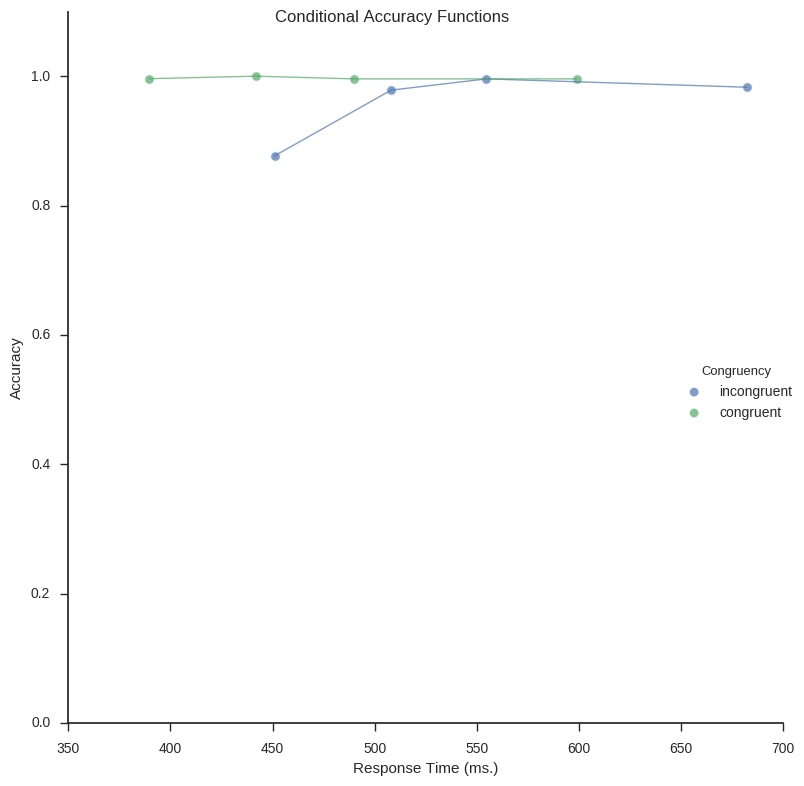
Update: I created a Jupyter notebook containing all code: Exploring distributions. If you need to learn more about saving Plots in Python.
References
Balota, D. a., & Yap, M. J. (2011). Moving Beyond the Mean in Studies of Mental Chronometry: The Power of Response Time Distributional Analyses. Current Directions in Psychological Science, 20(3), 160–166. http://doi.org/10.1177/0963721411408885 Luce, R. D. (1986). Response times: Their role in inferring elementary mental organization (No. 8). Oxford University Press on Demand.
Richard, P. (2014). The speed-accuracy tradeoff : history , physiology , methodology , and behavior. Frontiers in Neuroscience, 8(June), 1–19. http://doi.org/10.3389/fnins.2014.00150
Speckman, P. L., Rouder, J. N., Morey, R. D., & Pratte, M. S. (2008). Delta Plots and Coherent Distribution Ordering. The American Statistician, 62(3), 262–266. http://doi.org/10.1198/000313008X333493
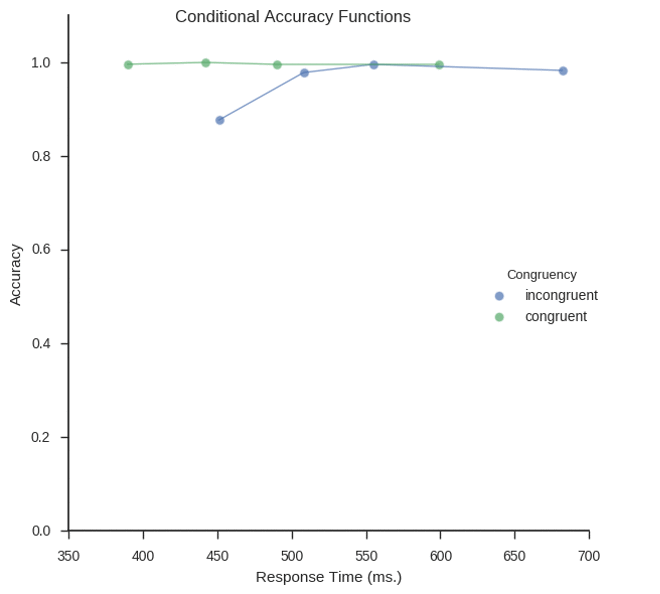
Hi, thank you for the great tutorial on delta plots, it was very helpful! Am I correctly assuming that index “rt” should be “dv” (lines 24&25) and “n_subjects” should be “subjects” (line 15) in order to use it straight away with my own data? Thank you.
Hi Klaas,
Glad you found it helpful and yes, you are correct. I will update and correct the code example!
Erik